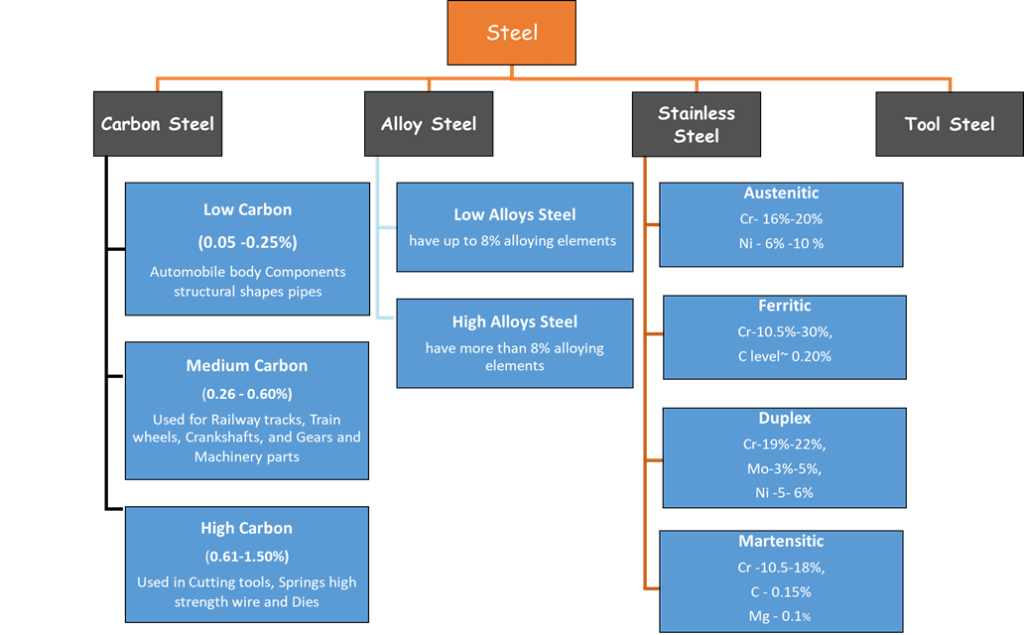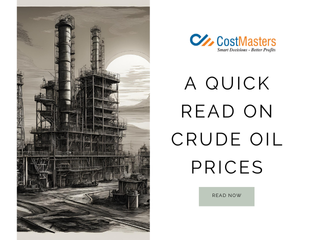Steel is a significant element in the automotive, infrastructure in India. Steel price frequent fluctuations due to changes in input commodities prices cause instability and have a significant impact on product pricing. Being such as the importance of steel, lets us understand how is steel made and what are the global dynamics of steel production.
India’s resilience, innovation, and growth have made us one of the major players worldwide in return contributing significantly to India’s economic growth.
How is Steel Made?
A key element of many industries, steel is made through a multi-stage, complex process that involves:
Mining of Raw Materials: The process involves the extraction of the raw materials required to produce steel. The primary ingredients are limestone, coal, and iron ore. The iron ore is extracted from the earth and refined in a blast furnace.
Ironmaking: Smelting is the process used to extract iron from iron ore. Limestone and coke are combined with iron ore in a blast furnace. Iron ore is transformed into molten iron by the extreme heat produced by burning coke. Slag is formed when impurities in the iron ore are removed with the help of limestone.
Steelmaking: The molten iron is transferred into steel once it is obtained. The Basic Oxygen Furnace (BOF) and the Electric Arc Furnace (EAF) are the two main techniques.
1. Basic Oxygen Furnace (BOF): Melted iron from the blast furnace is sent to a converter using the Basic Oxygen Furnace (BOF) technique. The molten iron is blasted with oxygen to eliminate contaminants such as silicon, manganese, and carbon. This procedure aids in varying the carbon concentration to produce steel grades.
2. Electric Arc Furnace (EAF): High-power electric arcs are used to melt scrap steel or direct-reduced iron. When recycling scrap steel, the EAF technique is more frequently employed for producing specialty steel.
Secondary Refining: Following the initial steelmaking process, further impurities are removed from the steel’s composition, and its qualities are adjusted using secondary procedures such as ladle refining, degassing, and alloying. These procedures guarantee that the steel satisfies client demands and particular quality criteria.
Continuous Casting: After the steel has been refined, continuous casting machines are used to cast it into semi-finished shapes like billets, blooms, or slabs. The molten steel is formed into certain shapes by this procedure, which is subsequently utilized for additional processing.
Forming and Finishing: To produce final products like sheets, bars, rods, beams, or wires, semi-finished steel products are shaped using techniques like rolling, forging, or extrusion. Before these products are prepared for the market, they could additionally go through surface treatments, heat treatments, and quality checks.

Type of Steel
It consists mainly of carbon and iron forming an alloy with the addition of ferroalloys to achieve a particular chemical composition. Due to these variations, steel prices vary from grade to grade. There exists a range of steel types each specifically engineered for applications
Carbon Steel
This alloy, which is mostly composed of iron and carbon, often contains up to 2% carbon by weight, while the exact percentage varies according to the use. Its qualities are directly impacted by the amount of carbon in it
Low Carbon Steel: it contains less than 0.3% carbon, low carbon steel has exceptional formability, weldability, and machinability. It is extensively utilized in the building, automotive, and pipeline industries.
Medium Carbon Steel: This type is stronger and harder, with a carbon content of 0.3% to 0.6%. It is widely used in equipment parts, structural elements, and railway tracks.
Alloy Steel
It is a type of steel that contains small amounts of elements other than iron and carbon, such as chromium, nickel, and molybdenum. These elements enhance the properties of steel, making it suitable for specific purposes.
Low Alloys Steel: Its alloy content remains under 8%. Low alloy steels strike a delicate balance between cost, strength, and versatility, making them indispensable in industries that demand enhanced mechanical properties without excessive costs. Low alloy steels find their niche in various industries and applications Automotive Manufacturing, Structural Engineering, Pressure Vessels and Pipes, Machinery and Equipment, Aerospace and Defense.
High alloy steel: Its alloy content remains over 8%. High alloy steel stands at the pinnacle of metallurgical excellence, comprising a complex blend of alloying elements that bestow extraordinary properties, elevating it above other steel types. High alloy steel is used in Aerospace and Aviation, Chemical and Petrochemical, Medical and Surgical Instruments, Energy, and Power Generation.
The fluctuation in alloying element price has a signification effect on alloy steel price.
Alloying Elements & their impact:

To get the latest Copper prices & Aluminium prices latest news & trends stay in tune with our newsletters
Stainless Steel
Austenitic: Austenitic stainless steel contains around Chromium 16-20% and nickel around 6% to 10 %, it exhibits remarkable corrosion resistance and high ductility. Renowned for its superb formability, it finds extensive use in kitchenware, architectural structures, and medical equipment.
Ferritic: Ferritic stainless steel is characterized by a high chromium content and low carbon content, typically around 10-30% chromium and very little to no nickel. It’s commonly used in automotive applications, kitchenware, and architectural designs due to its good formability and resistance to corrosion in certain environments.
Duplex: Duplex stainless steel, a robust alloy, combines the properties of both austenitic and ferritic stainless steels. Comprising a balanced mix of chromium, nickel, molybdenum, and sometimes nitrogen, it offers exceptional corrosion resistance and high strength. It ideal for demanding applications in industries like chemical processing, oil and gas, and marine engineering, where both strength and resistance to corrosion are crucial.
Martensitic: Martensitic stainless steel contains higher levels of carbon (around 0.1% to 1.2%) and lower amounts of chromium compared to other stainless steel. This steel type is commonly used in applications requiring high strength and durability, such as cutlery, surgical instruments, turbine blades, and some automotive components.
To get updated on stainless steel prices please follow our newsletters.
Tool Steel
Tool steel represents a category of high-quality, exceptionally durable steels tailored for the production of tools, dies, and cutting implements. These steels are engineered to withstand high temperatures, heavy loads, and repeated impacts. They possess qualities such as high hardness, wear resistance, and toughness, making them indispensable in manufacturing and toolmaking industries.

Steel is highly used in domestic alliances industries with a share of 52% followed by mechanical equipment industries with a share of 16%. Steel prices are heavily dependent on demands from these sectors and changes in the demand-supply equation can cause fluctuation in steel prices.

Top 10 Steel Producing Countries
China is the top manufacturer of steel, producing around 50% of the world’s steel production.

- China– China is the biggest steel producer in the world producing 1013 MMT (Million Metric Tonnes) in the year 2022, China Baowu Group is the biggest steel producer in China having the capacity to produce 120 MMT of steel. The global steel sector heavily depends on Chinese steel and any change in demand-supply situation can cause fluctuation in steel prices.
- India- India is 2nd largest producer of steel producing almost 125 MMT (Million metric Tonnes) in the year 2022. TATA Steel is one of the largest producers of steel and steel products in India having the capacity to produce 21 MMT.
Conclusion
The variety of steel types available, such as carbon steel and alloy steel with various alloying components, demonstrates the industry’s adaptability. Stainless steel and tool steel are two more instances of the material’s versatility. Tool steel is designed to last, and stainless steel comes in variants that resist corrosion.
Steel is majorly used in the mechanical equipment industries, having 52% and 16% of the respective shares, demonstrating the material’s critical importance in the domestic steel sector. China leads the world in steel production, influencing global dynamics and prices, with India following closely after. Tata Steel’s substantial participation in the Indian steel industry is a great advantage.
The development of India’s steel industry is critical to the nation’s automobile and infrastructure industries as well as to its overall economic growth. The Steel Prices fluctuate, which is correlated with the raw commodities prices and leads to volatility in the market.
